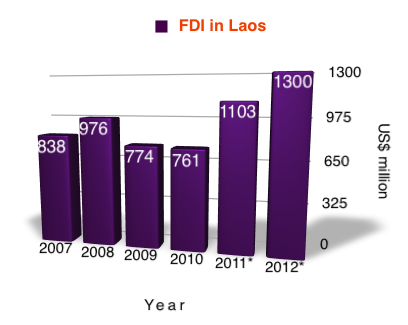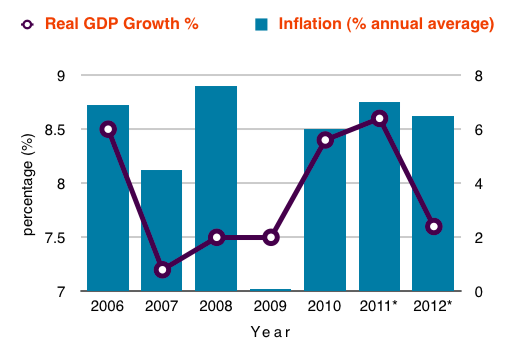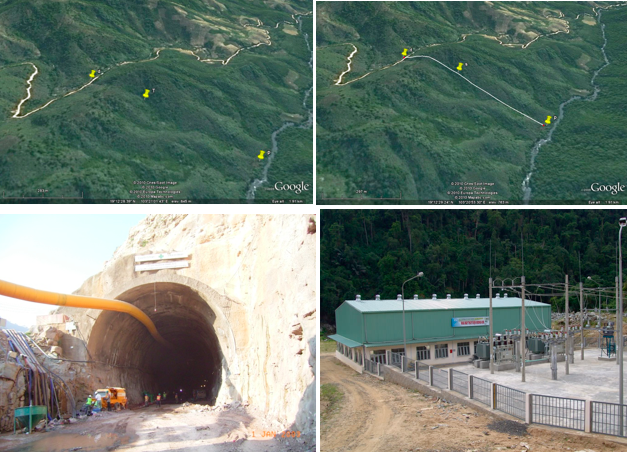
Laos 2012: at a Glance
  Source: MPI and staff estimates and projections Table: by Business-in-Asia.com Laos remains one of the poorest countries in Asia with a GDP per capita of $1,200. Twenty-seven percent of citizens are below the national poverty line and many live on about $1 per day. Laos is keen to expand its $7.5-billion economy and shed its status as one of the world’s poorest countries by 2020, reported the Bangkok Post newspaper. In comparing GDP per capita: Thailand was $8,500 in 2011, compared with Vietnam, $2,800; Cambodia, $2,100; Laos, $2,000; and Burma, $1,200. Laos' 7.5 billion economy is dwarfed by those of its neighbors - it is 790 times smaller than China's, 7% the size of Vietnam's, and 2% the sixe of Thailand. The surrounding economies of China, Thailand and Vietnam have competed for investment and influence in Laos. All three nations have invested fairly similar amounts in the country in the last 10 years - China $2.71 billion, Thailand $2.68 billion and Vietnam $2.77 billion according to the Bangkok Post with Thailand controlling most energy projects, the Chinese competing for mining and natural resources and the Vietnamese more focussed on farming and the consumer market.  Laos is aiming for growth of 8% a year over the next five years, 50-56% from foreign direct investment. Growth has averaged 7.9% since 2006 according to official statistics. Analysts say the best opportunities for foreign investors are in telecoms, tourism, financial services and agriculture. Brief Background Wedged between China to the north, Vietnam in the east, Cambodia to the south, Thailand in the west and Burma in the northwest, Laos occupies 237,000 sq km with an estimated population of 6.4 million. Independence was restored with the end of French rule in 1953. After the Vietnam war, the North Vietnamese-backed Pathet Lao replaced the monarchy with a communist government in 1975. The country has since run as a one-party system, with decisions taken by a highly cohesive 11-member politburo of the Lao People’s Revolutionary Party. The president and prime minister are chosen by parliamentarians elected by the people from among 190 candidates hand-picked by the ruling party. Laos elected a new 132-member national assembly in April 2011, with many new members said to be younger and better educated than before. The legislature in June chose President Choummaly Sayasone to serve a second term. In January 2011, Laos opened the world’s newest, and perhaps smallest, stock market, the Lao Securities Exchange (LSX), with two listed firms. Two more firms plan to list in early 2012 and three more by 2015. Prospects for Development and Situations in Laos: - Recent road projects to better connect
Thailand with neighboring
countries such as Burma, Laos and Cambodia have increased border trade
in Laos (see Thailand's
infrastructurez: between neighbouring countries)
- ASEAN are negotiating with the governments of countries in SE Asia to issue a single visa, for Thailand, Burma, Laos, Cambodia and Vietnam to promote regional tourism. In addition, a one-stop-tax collection system should be developed to reduce operational costs for entrepreneurs transferring goods through the region by land. - Mekong: the security and stability of the Mekong River. China, Laos, Myanmar and Thailand recently launched joint patrols on the "golden waterway". The four countries, all members of GMS, have vowed to safeguard shipping and crack down on cross-border crimes on the river. - The Bank of Thailand reported that Thai-Laos border trade declined to 5.36 billion baht in June 2011, a 25.7% decrease from the same period in 2010, partly because Laos can now domestically produce construction materials. In addition, the economic crisis has reduced Thai exports of petrol, machinery and plastic to the Laos. - The AEC has plans on integration of the less-developed CLMV (Cambodia, Laos, Myanmar (Burma), Vietnam) members, and financial integration, which will require a quite more challenging plan. Experts estimated that by 2015, the AEC vision will likely be only partially implemented in the four least developed ASEAN countries noted above. Economists are bullish about Laos longterm potential but see immediate issues with corruption, incomplete and often not well thought out regulations, limited banking oversight and limited or inadequate infrastructure. Laos is addressing many of these issues but change has not moved with a speed sufficient to satisfy the IMF and many major international partners. About the Author: Christopher W. Runckel, a former senior US diplomat who served in many counties in Asia, is a graduate of the University of Oregon and Lewis and Clark Law School. He served as Deputy General Counsel of President Gerald Ford’s Presidential Clemency Board. Mr. Runckel is the principal and founder of Runckel & Associates, a Portland, Oregon based consulting company that assists businesses expand business opportunities in Asia. (www.business-in-asia.com) Until April of 1999, Mr. Runckel was Minister-Counselor of the US Embassy in Beijing, China. Mr. Runckel lived and worked in Thailand for over six years. He was the first permanently assigned U.S. diplomat to return to Vietnam after the Vietnam War. In 1997, he was awarded the U.S. Department of States highest award for service, the Distinguished Honor Award, for his contribution to improving U.S.-Vietnam relations. |
